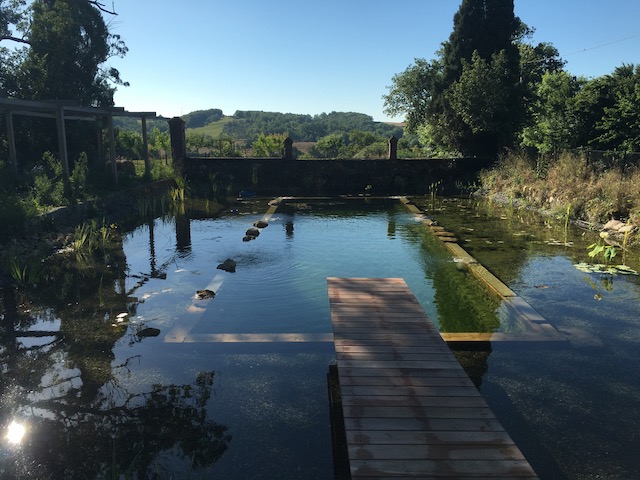Swimming pools are often high on the wish-list of people looking to buy a house in France and they can be a great source of fun for family and friends. But they can also be an expensive luxury, not only in terms of cost but also effects on the environment thanks to the energy needed to heat and maintain a pool, the chemicals to keep it clean and, of course, the water to fill it and keep it topped up. There are, however, plenty of ways to make it more energy efficient and sustainable.
1. Eliminate chlorine
Chlorine is a dangerous chemical that is a carcinogen and has been linked to asthma, rashes, skin irritation, headaches, and other problems. In addition, chlorine forms a gas that can be inhaled by people who are not even swimming. The best way to ensure your swimming pool is environmentally friendly is to use the alternative of copper/silver with oxygenation instead of chlorine or salt to purify the water. This is a cheaper and safer method of making your swimming pool water pure – pure enough to drink.
Another popular choice is to add a saltwater generator which converts the salt you add to chlorine but in much smaller quantities. This makes the water friendly on the skin and eliminates the chlorine smell so that people with respiratory problems such as asthma are less effected by the smell of chlorine. The water is also clearer, feels silkier and smooth.
2. Use eco-friendly technologies
Harness the sun
One of the most eco-friendly and cost-effective ways to run your pool is to use solar power. Installing 2-3kW of solar panels is sufficient to cover the cost of running the pool pump, filter etc especially if you set the pool pump on a timer, generally between 10am and 3pm in summer to ensure that you are using your solar power for energy use.
Invest in a thermal pool cover or solar ‘bubble blanket’
Covering a pool when it’s not in use is a simple yet effective way to reduce environmental impact by retaining heat, reducing evaporation, and maintaining chemical balance. Various covers are available, the most effective being thermal covers designed to withstand strong UV so that they last longer and have greater insulating properties. Alternatively, solar covers or bubble blankets contain air pockets that absorb heat from the sun and transfer it to the water, heating your pool. A good solar cover can heat your pool by up to eight degrees, however they are not as effective as thermal covers at retaining heat overnight. Typically, more affordable than thermal covers, solar covers tend to have a shorter lifespan.
Don’t overuse the pump
A pool pump running 24 hours a day can produce as much greenhouse gas as a large car over a year. To reduce emissions and costs, it is therefore important to use a timer to manage your pump’s running time and run it off-peak if possible. Many pool professionals recommend that pumps run anywhere from 6- 12 hours per day but most debris is only found at the top of the pool meaning you can run your pump for less time. To keep your pump running as efficiently as possible it is also recommended to regularly clean the skimmer basket, pump basket and filter and keeping your intake grates clear of debris.
3. Water neutral pools
For pool owners who are concerned about water and energy usage, water-neutral pools offer an easy solution. Water-neutral pools use a combination of water-saving and water-harvesting devices such as water tanks to collect rainfall to top up the pool, and backwash-minimisation systems to minimise environmental impact by reducing the amount of overall water needed to maintain a swimming pool.
4. Natural pools
A natural swimming pool is completely chemical free and takes inspiration from nature to help filter any harmful bacteria and dirt. Natural pools rely on biological processes to purify the water using aquatic plants native to the area, and thus act as part of the local ecosystem. Traditionally, a natural swimming pool consists of a swimming area and a planted area. The planted area is essentially a built-in natural ecosystem made of plants that are low maintenance and ensure that the water remains clean and clear and it is this “regeneration zone” that allows the pool to essentially clean itself. Water from the pool is circulated into this zone, where aquatic plants filter it and boost oxygen levels. Strategically placed rocks and gravel also assist with the purification process. The water filters through the plants which absorb any bacteria and release the clean water back into the swimming area.
Unfortunately, natural pool installation tends to cost about twice that of traditional pools, but you will save money on chemicals and also on electricity, as most pumps are not pressurised, and thus use much less energy. In the long term, therefore, a natural pool can also be cost-effective and cheaper to run than a traditional pool.
If you need help to find and buy your dream home in France, please get in touch: nadia@foothillsoffrance.com






You must be logged in to post a comment.